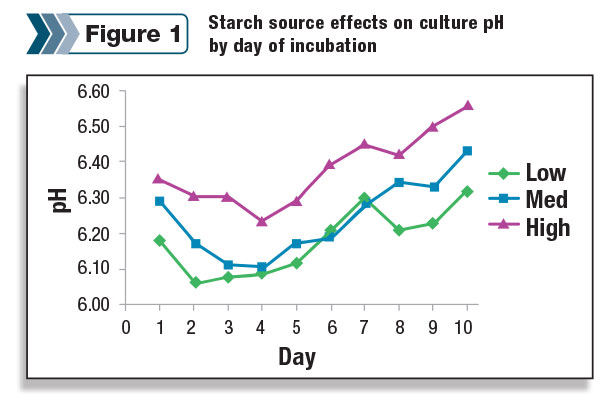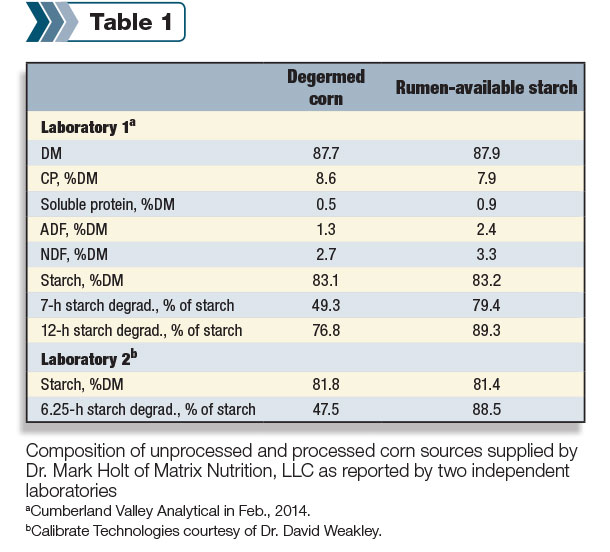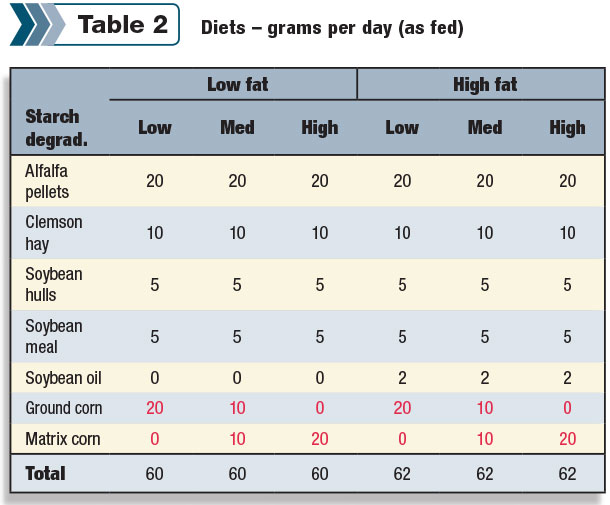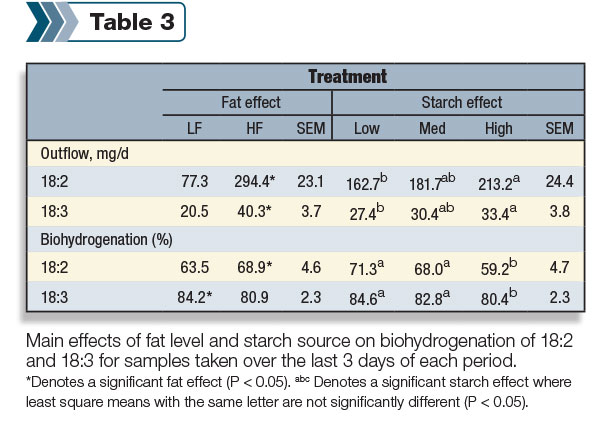Editor’s note: This is the first of a three-part series. In the world of dairy nutrition, with sophisticated models, curvilinear optimization and five-plus decimal accuracy, one of the greatest problems we face is delivering starch to the lactating cow with precision.
In most dairy diets, starch is the number one cost component; however, it has the greatest degree of variability. Current seven-hour in-vitro starch digestibility analysis has a coefficient of variation (CV) of plus or minus 25 percent. In comparison, neutral detergent fiber (NDF) currently has a CV of 3 percent.
In addition, passage rates can vary from 2 percent to 22 percent, while most models use relatively static passage rates. Passage rate is as important as digestion rate, since post-ruminal starch contributes primarily to tissue maintenance and body condition and little to milk production.
So our objective should be to deliver the most starch to the rumen while maintaining a high rumen pH. Based on past research, some would say this is an anomaly, but new data indicates it could be achievable.
Some have stated the quest for precision in this area is impossible; however, a healthy scientific approach would open discussion of what we know, define the questions of what we need to know and pursue a systems approach to answer those questions with precision in order to reach our objective of starch digestion efficiency.
Starch chemistry and digestion kinetics are quite complex. In addition, the dairy cow will partition nutrients based on her metabolic needs. The very nature of the starch matrix is complicated because it has become a moving target. Changes have occurred in genetic composition of corn nutrients such as amylose, amylopectin and increasing zein content (a highly hydrophobic protein, soluble in isopropanol or ethanol).
Zein is a prolamine – an alcohol-soluble protein present in amounts of 2.5 to 10 percent (dry basis) in corn. Zein is a common component used in the manufacture of plastics, paper coatings, adhesives, substitutes for shellac, laminated board and solid-color printing films. So as the zein content of corn increases, the digestibility to ruminants decreases without further processing. These compounds wreak havoc with models trying to predict rumen digestibility.
Shifts in the ratios of amylopectin (most digestible) to amylose (least digestible) have been reversed from 3-to-1 to 1-to-3. While making these changes, the amount of enzymes (amylases and proteases) available to reduce these starches are quite variable between cows. Most corn today can contain up to 95 percent vitreous starch.
Physical characteristics have also changed. Increased density creates a polymer that repels water or rumen fluid. Water uptake from corn and corn products varies from a ratio of 2-to-1 to 7-to-1.
Nomenclature for describing corn is also confusing, with the following terms being used without consistency, precision or accuracy: crystalline, horneous endosperm, vitreous, hydrophobic, hydrophilic, amylose, amylopectin, resistant starch, prolamine, glutelin, zein, etc. When we add the changes in the grain, it compounds the problems further and makes the landscape quite confusing; however, there is hope.
In this malaise of variability and confusion, our job should be to create a system for starch digestion and milk production that is efficient and highly predictable. In order to create this system, I believe there are three tenets that should be considered and refined to build this system.
Tenet 1
Site of digestion – Post-ruminal starch contributes little if any glucose for milk production.
Tenet 2
Starch digestion variability – Systems should be devised to reduce the 30 percent CV.
Tenet 3
Passage rate of starch is as important as digestibility.
This is the first of a three-part series to address these questions, with site of digestion being the first topic for discussion.
Site of digestion – starch
Without stating the obvious, a dairy cow’s starch requirements are different than a beef cow. Starch/glucose is partitioned at different sites in the gastrointestinal track for different purposes. The following is a review of the research and fate of post-ruminal starch and glucose.
With the amount of data in print, I am always amazed at the number of dairy nutritionists that focus on fecal starch as a proxy for the starch digestion efficiency in the dairy cow. This is a wonderful tool for the beef nutritionist, but the objectives for the dairy nutritionist are quite different.
We also know there is an upper limit for starch digestion post-ruminally. Appreciable amounts of dietary starch may escape ruminal fermentation.
In addition, research in 1981 found that up to 1.6 kg of glucose infused into the abomasum of cows disappeared from the gut, and this was presented as an upper limit of starch that can be digested and absorbed by the hindgut. Beef heifers absorbed four times as much glucose as the dairy cow from the abomasum.
In 2001, researchers wrote that starch digested post-ruminally was used with high efficiency for tissue energy retention as protein and fat. In addition, the small intestine starch digestion provides glucose for absorption, while ruminal starch digestion provides volatile fatty acids (VFA), which contribute to net glucose absorption in the liver.
Another study stated, “Production studies show no clear evidence that post-ruminal digestion enhances milk yield or composition.” Other studies have found post-ruminal starch can actually be more detrimental than beneficial to milk yield and components.
In Europe, we find parallel responses with surplus glucose being stored in the liver and skeletal muscle, and longer-term as body fat. Absence of post-ruminal effect on milk yield indicates that the mammary gland is at maximum capacity or other factors set the upper margin for milk production.
Post-ruminal starch and its fate
I think these studies conclude that we have an upper limit to conventional starch fed in the rumen and post-ruminally. The objective should be to feed as much rumen-available starch without compromising pH and rumen function.
Most research has concluded an upper limit for rumen-degradable starch due to the decrease in pH, decreased NDF digestibility and increase in propionate. Tom Jenkins of Clemson University has researched a starch source in his protozoa-populated fermenters that increased pH, shifted VFAs from the propionate-to-acetic VFA ratio and increased passage rate of certain fatty acids 400 percent.
This research indicates that with unique processing, corn can become a source for increased endogenous protein while increasing pH and bypassing certain fatty acids. In addition, it eliminates the variability with regards to feeding starch source to the lactating dairy cow.
Figure 1 and Tables 1, 2 and 3 show the findings for the current study. Subsequent research is in process to further understand the population and volume increase in microbial protein, protozoa, bacteria and the reverse response of pH and starch.




Implications for using products of this nature are far-reaching and could mitigate the limits for starch that have been faced in the past. PD
References omitted due to spacebut are available upon request. Click here to email an editor.
Mark Holt is with Matrix Nutrition LLC. He can be reached by email.





